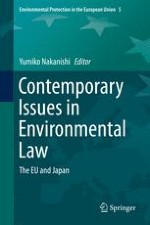2016 | OriginalPaper | Chapter
8. The Challenge of Regulating Genetically Modified Organisms in the European Union: Trends and Issues
Author : Hans-Georg Dederer
Published in: Contemporary Issues in Environmental Law
Publisher: Springer Japan
Activate our intelligent search to find suitable subject content or patents.
Select sections of text to find matching patents with Artificial Intelligence. powered by
Select sections of text to find additional relevant content using AI-assisted search. powered by
